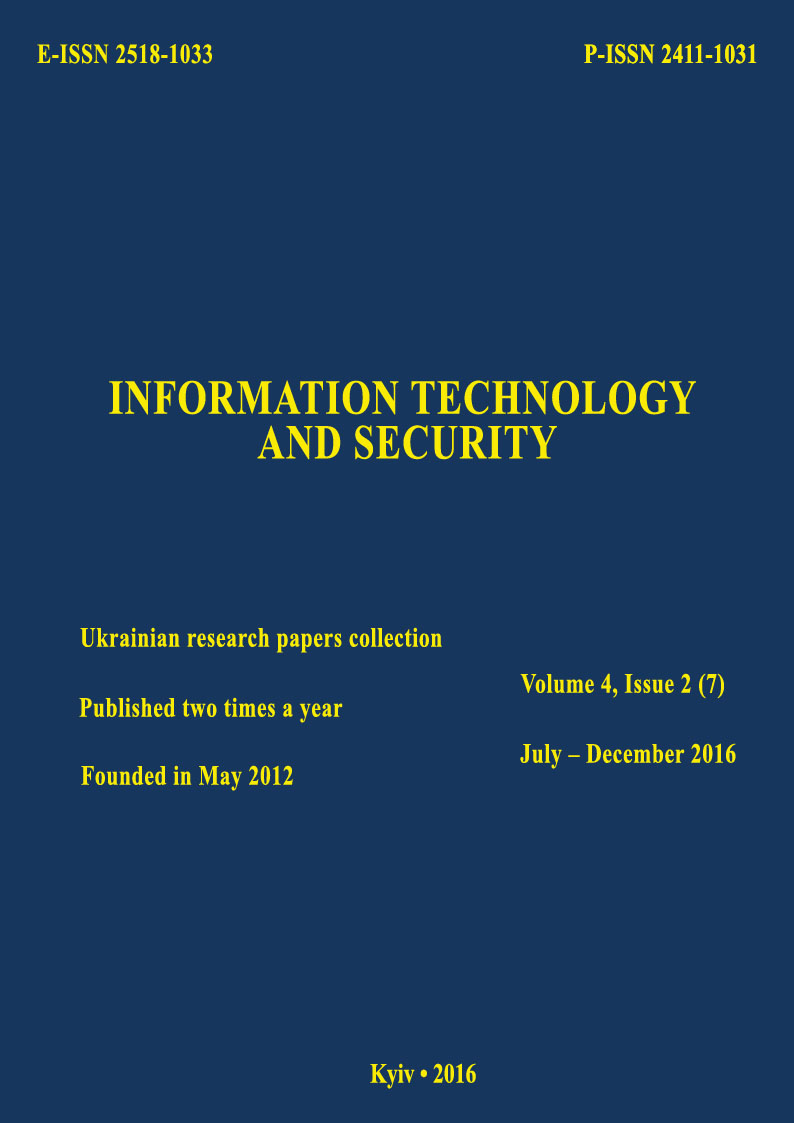Decreasing the total number of logic elements in the classis two-step multiplier with a help of Vivado HLS
DOI:
https://doi.org/10.20535/2411-1031.2016.4.2.109997Keywords:
Information security, Galois field, Vivado HLS, VHDL, classic two-step algorithm, arbitrary precision typesAbstract
В Україні практично всі реалізації захисту інформації є програмними, основним недоліком яких, є недостатня стійкість до зламу, тому для збільшення надійності реалізації захисту інформації виникає необхідність у створенні апаратних засобів для виконання операцій над елементами скінченних полів. Однією з можливостей є реалізація на програмованих логічних інтегральних схемах. Як правило, помножувачі в полях Галуа будуються за допомогою засобів мови VHDL. Основним недоліком такого підходу є значні часові та апаратні затрати. В даній статті, запропоновано будувати помножувач у полях Галуа за допомогою середовища Vivado HLS. В роботі розглянуто метод оптимізаціїї при якому використовувались типи з визначеною точністю. В результаті досліджень, було доведено ефективність використання середовища Vivado HLS у порівнянні із засобами VHDL. Кількість найпростіших логічних елементів було зменшено у 3 рази, а також кількість тригерів із динамічним і потенційним управлінням скоротились вдвічі. Використання даного методу дає можливість розробляти помножувачі у полях Галуа з великим порядком.
References
W. Tan, and L. Yip, “Hardware implementation of genetic algorithms using FPGA”, in Proc. 47th IEEE International midwest symposium. Circuits and Systems, Hiroshima, Japan, 2004, pp. 549-552.
doi: 10.1109/MWSCAS.2004.1354049.
J. Rose, et al., “The VTR Project: Architecture and CAD for FPGAs from Verilog to routing”, in Proc. 20th ACM/SIGDA International symposium. Field-Programmable gate arrays, Monterey, California, USA, February 2012, pp. 77-86.
doi: 10.1145/2145694.2145708.
P. Kitsos, G. Theodoridis, and O. Koufopavlou, “An efficient reconfigurable multiplier architecture for Galois field GF(2m)”, Microelectronics Journal, vol. 34, iss. 10, pp.975-980, October 2003.
doi: 10.1016/S0026-2692(03)00172-1.
Y. Li, G. Chen, and X. Xie, “Low complexity bit-parallel GF(2m) multiplier for all-one polynomials”, IACR Cryptology ePrint Archive, pp. 414, 2012.
G. Baguma “High Level Synthesis of FPGA-Based Digital Filters”, M.S. thesis, Department of Information Technology, Uppsala University, Uppsala, Sweden, 2014.
М. Zwagerman, “High Level Synthesis, a Use Case Comparison with Hardware Description Language”, M.S. thesis, Grand Valley State University ScholarWorks, Allendale, Michigan, USA, 2015.
S. Brad, “Tincr. Integrating Custom CAD Tool Frameworks with the Xilinx Vivado Design Suite”, M.S. thesis, Brigham Young University, Provo, Utah, USA, 2014.
Y. Sholohon, “Evaluation of structural complexity Galois field multipliers based on the elementary transducers”, Proceedings of the national university “Lviv Polytechnic”: Computer systems and networks, no. 806, pp. 290-296, 2014.
O. Sholohon, “Structural Complexity of Galois Field GF(2m) Elements Multipliers in Polynomial Basis Calculation”, Proceedings of the national university “Lviv Polytechnic”: Computer systems and networks, no. 806, pp. 284-289, 2014.
V.S. Hlukhov, R. Elias, ta A.O. Melnyk, “Features of the FPGA-based Galois Field GF(2m) Elements Sectional Multipliers with Extra Large Exponent”, Computer-integrated technologies: education, science and industry, no. 12, pp. 103-106, 2013.
“Xilinx. Vivado design suite user guide high-level synthesis”, Xilinx, Inc., San Jose, California, USA, Tech. rep. (v2013.4), Dec. 2013.
“Xilinx. Vivado design suite user guide high-level synthesis”, Xilinx, Inc., San Jose, California, USA, Tech. rep. (v2014.1), Xilinx, Inc., May 2014.
“Zynq-7000 All Programmable SoC PCB Design Guide”, Xilinx, Inc., San Jose, California, USA, UG933 (v1.12), Sept. 2016.
Downloads
Published
How to Cite
Issue
Section
License
Copyright (c) 2020 Collection "Information technology and security"

This work is licensed under a Creative Commons Attribution 4.0 International License.
The authors that are published in this collection, agree to the following terms:
- The authors reserve the right to authorship of their work and pass the collection right of first publication this work is licensed under the Creative Commons Attribution License, which allows others to freely distribute the published work with the obligatory reference to the authors of the original work and the first publication of the work in this collection.
- The authors have the right to conclude an agreement on exclusive distribution of the work in the form in which it was published this anthology (for example, to place the work in a digital repository institution or to publish in the structure of the monograph), provided that references to the first publication of the work in this collection.
- Policy of the journal allows and encourages the placement of authors on the Internet (for example, in storage facilities or on personal web sites) the manuscript of the work, prior to the submission of the manuscript to the editor, and during its editorial processing, as it contributes to productive scientific discussion and positive effect on the efficiency and dynamics of citations of published work (see The Effect of Open Access).

